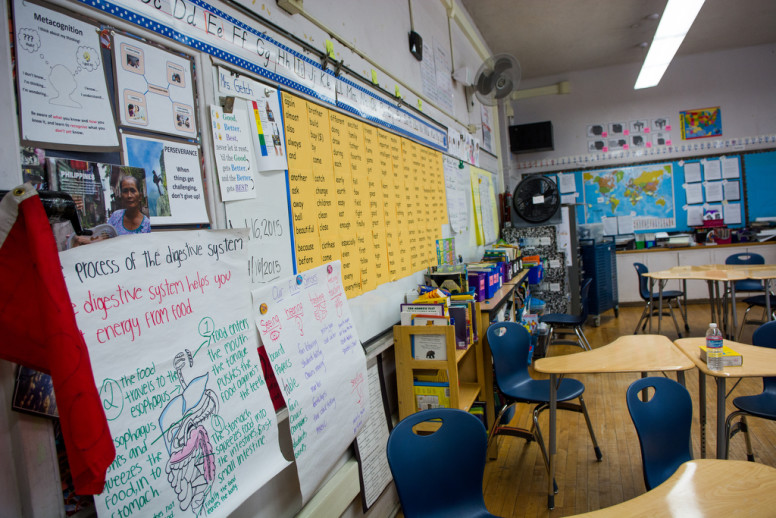In the massive return to schools underway across San Diego, one group is noticeably hanging back: high schoolers.
Age, across the board, plays a big role in whether students and their families are choosing to return to campus, according to a Voice of San Diego analysis of reopening data collected by the San Diego County Office of Education.
Only 32 percent of elementary students remain in full-time distance learning. In middle school, 41 percent are learning remotely. And in high school, 53 percent of students have decided to stay home.
In San Diego Unified, the high school data is even more stark. A full 60 percent of high schoolers remain in full-time distance learning.
The analysis of countywide data revealed several other findings.
The biggest portion of public school students is still learning online, every day: 42.7 percent are learning online-only; 41.7 percent are doing hybrid learning and 15.6 percent are learning in person full time.
Private school students are still far more likely to be going to their physical campuses: Just 18 percent are in full-time remote learning.
Some leaders feared that high-poverty schools might have the fewest students returning to campus. But with the exception of a few outliers, the analysis showed no meaningful correlation between a school’s poverty level and how many students are returning to campus.
The trend of high schoolers not returning to campus could have troubling implications for the future, some education advocates said.
“I’m concerned,” said Tyrone Howard, a professor of education at UCLA. “I’m concerned because there’s a general thinking among school leaders I’ve talked to that when the fall comes, all the students will come back. And we don’t have any data or evidence to verify that.”
Ultimately, there could be many reasons older students aren’t willing to return. Some may be disengaged and not want to return simply because they don’t love school. Others may be needed at home to take care of younger children. Some may have discovered they prefer an online education. One high school senior told the Los Angeles Times it wasn’t worth it for her to come back just for two months.
Others may not have been served well in public schools before the pandemic.
“My research is around Black students, and Black students have not been served well by schools for decades if not longer,” said Howard. “Some parents may be thinking, ‘Why should I send my child back to that environment if there is something different I can offer?’”
The pandemic presents leaders with an opportunity to make schools better and more welcoming for all, Howard said. Schools might develop more well-rounded curriculums that reflect the history of people of color and find solutions to the deep disparities in discipline that plague Black students, he said, in order to persuade young people to return.
In that regard, San Diego Unified board president Richard Barrera agrees. Barrera mentioned curriculum and discipline as two things that should be improved. He also pointed to two changes in the works at San Diego Unified. High schools across the district recently adopted later start times. And next year they’ll start using what’s called a four-by-four schedule, which means students only take four – instead of six or seven – classes per day.
But Barrera said he’s not too worried that a large portion of students won’t return in the fall. He believes the majority of students who aren’t coming back still don’t feel safe.
“When we get to the fall, we expect there will be a much lower percentage of parents and students concerned it’s not safe to come back,” he said.
In order to make sure most students return, some places, like New York City schools, will not offer remote learning to the majority of students.
But Barrera said that isn’t the right route to take. It’s important to give parents and students the opportunity to decide for themselves whether it’s a good idea to come back, he said.
“Do you take a position where you say, ‘Well that’s just a wrong way of thinking,’” he said. “We’re not going to deny that [online learning] option. Our district is saying, ‘We’ve learned a lot from COVID – and most of it has been a nightmare – but some of it has been positive and creating an online academy is a benefit we can take out of the pandemic.’”
Howard agrees that students and parents deserve to have the agency to choose.
“Ironically, I had a conversation about this with my 15-year-old niece a few weeks ago. She is of the opinion that she doesn’t want to go back. She said she doesn’t want to go back because she can work from her room and at a time when she wants to. She can do the work independently. It works for her,” he said.
“If it’s working for you, I can’t argue with that,” Howard told her.
Both Barrera and Howard also agree that traditional public schools may have to do much more outreach next year to make sure parents and students are comfortable enough to return. But that outreach and messaging will have to be backed up by real promise, said Howard.
“We’ve often times looked for a moment in time to say schools will do better by all students, not just middle-class White kids, but Black, Brown and poor students. Public schools have never been incentivized to do better. Charter schools posed a threat. But there’s never been a moment like this with 30 and 40 percent of students not showing up,” he said.
Majority of San Diego High Schoolers Staying in Full-Time Distance Learning Source link Majority of San Diego High Schoolers Staying in Full-Time Distance Learning

